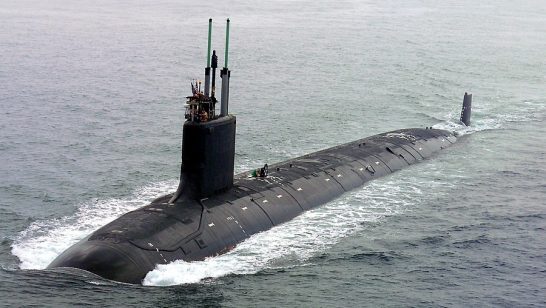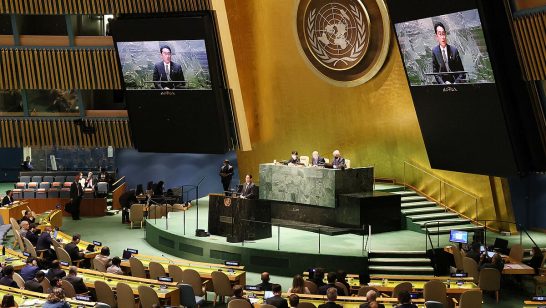
The trilateral Australia-United Kingdom-United States (AUKUS) partnership’s drive to provide Australia with nuclear-powered submarines continues to stoke debate among Member States of the International Atomic Energy Agency (IAEA), primarily between China and Russia on one side and the AUKUS countries on the other. Per the 2023 announcement from the AUKUS countries that they would continue with the programme, we now know what comes next: capacity building for Australia’s submariners, the sale of US Virginia-class submarines, and the later joint development and deployment of new nuclear-powered submarines called the SSN-AUKUS. This issue featured prominently last month as States Parties to the Treaty on the Non-Proliferation of Nuclear Weapons (NPT) gathered in Vienna.
Questions were again raised on how the nuclear material that will be used for the submarines can be accounted for under Australia’s comprehensive safeguards agreement – a legal instrument that all non-nuclear-weapon States under the NPT are required to conclude with the IAEA to ensure that nuclear technology is not used to develop nuclear weapons. These agreements include a provision that the State must invoke for the “non-application” of the safeguards on nuclear material they would normally be subject to for cases in which the State intends to use nuclear materials in a non-explosive military capacity, as is permissible under the agreement. One requirement of that provision is that the State must make an arrangement with the IAEA to ensure that the material will not be diverted for nuclear weapons purposes, as routine safeguards measures under the agreement are not applied – other verification measures would be conceived here. An example of an activity to which such an arrangement would apply is naval nuclear propulsion.
Questions were again raised on how the nuclear material that will be used for the submarines can be accounted for under Australia’s comprehensive safeguards agreement - a legal instrument that all non-nuclear-weapon States under the NPT are required to conclude with the IAEA to ensure that nuclear technology is not used to develop nuclear weapons. Noah Mayhew
I spent some of the early days of AUKUS debunking misinformation about the legal status of naval nuclear propulsion (for example, this brief). Over two years since the AUKUS partners announced initial plans for a feasibility study on providing Australia with nuclear-powered submarines, misinformation has somewhat waned. Nonetheless, as the partners move forward, it is useful to consider how opponents of the partnership continue to debate in the IAEA context.
How should the IAEA’s policymaking organs handle Australia’s safeguards arrangement?
The primary request made by opponents to the AUKUS partnership has been the creation of a special committee of the IAEA’s Board of Governors—one of its two primary policymaking organs—to negotiate a model safeguards arrangement for nuclear material in non-nuclear-weapon States’ naval nuclear propulsion programmes. While this could be seen as a reasonable request on its face, it is unrealistic for a few reasons.
First, for a model arrangement to be effective, it would have to be easily applicable to any State that wished to exercise its right to conclude such an arrangement. A safeguards arrangement for Australia could bear little resemblance to an arrangement for a country with different circumstances. Consider the example of Brazil, the only other non-nuclear-weapon State actively developing a naval nuclear propulsion programme. Australia and Brazil have very different domestic nuclear capabilities, so the safeguards arrangement for each country would naturally look very different. This is one of the reasons why the IAEA designs State-level safeguards that are tailored to the State concerned, based on six State-specific factors. Experts have rightly pointed out that the State-level approach for Australia would need to be revised to reflect its naval propulsion programme.
Second, the efficacy of committees of the Board is highly dependent on the prevailing political conditions. Based on my study of official oral records, the divisiveness within the Board is currently worse than during the last such committee, known as Committee 25 (2005-2007). In its two years of operation, Committee 25 – established to identify measures to strengthen safeguards further – was unable to agree on a single consensus recommendation. A programme of work for the committee was never established, the discussions within the committee were largely political in nature rather than technical, and the vehicle for funding the committee was unclear for most of its duration. The types of problems that plagued Committee 25 would almost certainly pose significant barriers to a new special committee.
A safeguards arrangement for Australia could bear little resemblance to an arrangement for a country with different circumstances. Noah Mayhew
Alternatively (and at times concurrently), opponents to the AUKUS partnership have argued for establishing an open-ended working group of experts. The group would be open to any interested IAEA Member State to feed into what a model arrangement would look like, as well as to ensure that there is a sustained dialogue on this issue. In my analysis, the risks of this approach do not significantly differ from those of a special committee of the Board. Moreover, in regular board meetings that occur five times per year, naval nuclear propulsion already often enjoys two official agenda items, plus discussion under the “any other business” item. It is doubtful that the creation of a second track would add value, and it might even be counterproductive.
The most realistic way to proceed under current conditions is for the Australians and the IAEA Secretariat to continue their consultations and submit the arrangement “for appropriate action” to the Board of Governors. Such an arrangement would need to satisfy the technical verification objectives of the IAEA. The phrase “for appropriate action” was most recently noted in the IAEA Director General’s statement from March 2023, though its meaning is unclear. Whatever the Board decides “appropriate action” constitutes will be the precedent that is set.
What does transparency mean in the negotiation of the arrangement?
Since the AUKUS partnership was first announced, opponents have called for transparency. The AUKUS countries, for their part, have claimed that they are proceeding with the highest degree of transparency as they continue to consult with the IAEA Secretariat. Perhaps the better question here would focus on transparency about what exactly?
The AUKUS countries should, indeed, be expected to act as transparently as possible. However, it is unrealistic to expect Australia to open its private consultations with the Secretariat to all IAEA Member States about an arrangement allowed for in the type of safeguards agreement that almost every other country has in force. Such demands could set a precedent that would open future private consultations of Member States to scrutiny by the Board of Governors. This is not to say that, once the IAEA and Australia are satisfied that the arrangement is sufficient to satisfy the IAEA’s technical safeguards objectives, Australia could not brief the Board—I believe they should and certainly would.
The most realistic way to proceed under current conditions is for the Australians and the IAEA Secretariat to continue their consultations and submit the arrangement “for appropriate action” to the Board of Governors. Noah Mayhew
Another concerning aspect of these calls for transparency is that they cast undue doubt on the IAEA’s ability to implement its technical mandate. The provision for this kind of arrangement in non-nuclear-weapon States’ safeguards agreements (elaborated in the IAEA document INFCIRC/153) was envisaged by the drafters. Director General Grossi has confirmed this in numerous statements. Repeated calls for transparency imply that the IAEA is not being transparent when it has simply clarified the negotiating history of INFCIRC/153.
On that note, much of the opposition to this issue in Vienna seems to centre on the belief that the transfer of large quantities of highly enriched uranium (the fuel that will power the submarines) is unprecedented. The case is, indeed, novel, but in the past, the United States and the Soviet Union had supplied highly enriched uranium for research reactors to non-nuclear-weapon States for decades. While the transfer envisioned under AUKUS is contrary to global efforts to reduce stocks of highly enriched uranium, it is hardly unprecedented. Once again, the challenge is for the IAEA and Australia to agree on an arrangement that satisfies the IAEA’s technical verification objectives.
So, what does transparency mean in this case? Transparency means the Secretariat reporting to the Board of Governors when new information is available, briefing the Board on the nature of an arrangement and how it provides assurance that nuclear material is not diverted for weapons development, and submitting it for action when the time comes.
What’s the historical record on naval nuclear propulsion and safeguards?
Another commonly heard argument on naval nuclear propulsion and IAEA safeguards in recent months concerns the accessibility of the negotiating records for INFCIRC/153. This document defines the structure and content of safeguards agreements with non-nuclear-weapon States. It also includes the provision for the non-application of safeguards measures on non-prohibited nuclear activities noted above. As such, the negotiating records for that provision are particularly important in this context. Early critics of the AUKUS partnership claimed that the negotiating records for INFCIRC/153 remain sealed, though they are available upon request from the IAEA’s archives. Later criticisms along this vein shifted to the difficulty in accessing these documents, arguing that they should be available on the IAEA’s public website, considering they have long since been derestricted.
So, what does transparency mean in this case? Transparency means the Secretariat reporting to the Board of Governors when new information is available, briefing the Board on the nature of an arrangement and how it provides assurance that nuclear material is not diverted for weapons development, and submitting it for action when the time comes. Noah Mayhew
As with the repeated calls for transparency, these criticisms imply that the IAEA is acting in bad faith by withholding negotiating records for political purposes. The committee that negotiated INFCIRC/153 – Committee 22, or the “Safeguards Committee” – is one of 25 committees formed by the Board, which have extensive oral records. The IAEA’s archives office is relatively small, as is the office managing its website.
Should Member States remain concerned that these and other records are not accessible to the general public, a way to remedy this would be to make an official request for all derestricted records to be published on iaea.org. This should be paired with an offer to fund several cost-free experts for the archives and public information offices to conduct this work. Indeed, it would be ideal for these records to be accessible to the general public.
Looking to the General Conference
Last year at the IAEA’s annual General Conference, AUKUS took up a lot of bandwidth, including a resolution on AUKUS proposed by the Chinese delegation alongside AUKUS-related language in other conference resolutions (none of which were adopted). What will this year bring? What I would hope to see during this year’s General Conference is for debates on AUKUS to be informed, constructive and less divisive. As IAEA Member States engage in consultations on this issue, they should have front of mind that undermining the IAEA’s technical mandate will come at a cost.
The opinions articulated above represent the views of the author(s) and do not necessarily reflect the position of the European Leadership Network or any of its members. The ELN’s aim is to encourage debates that will help develop Europe’s capacity to address the pressing foreign, defence, and security policy challenges of our time.
Image credit: Wikimedia Commons / U.S. Secretary of Defence



